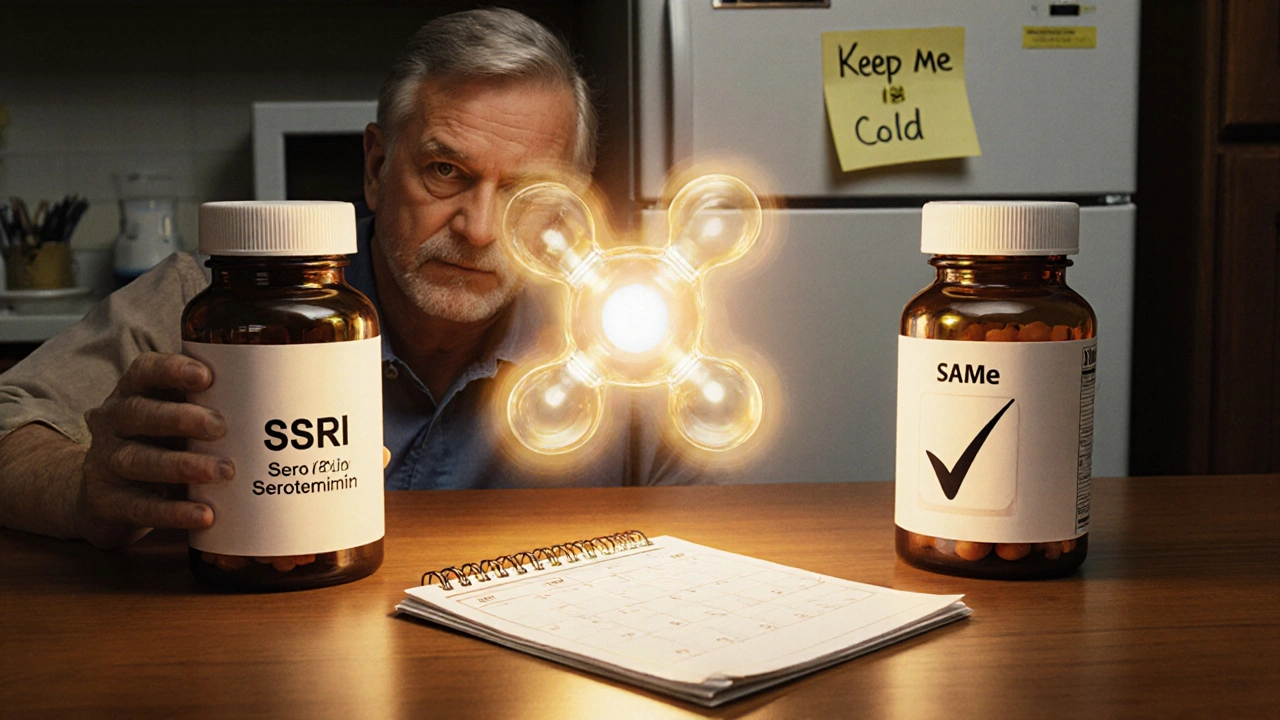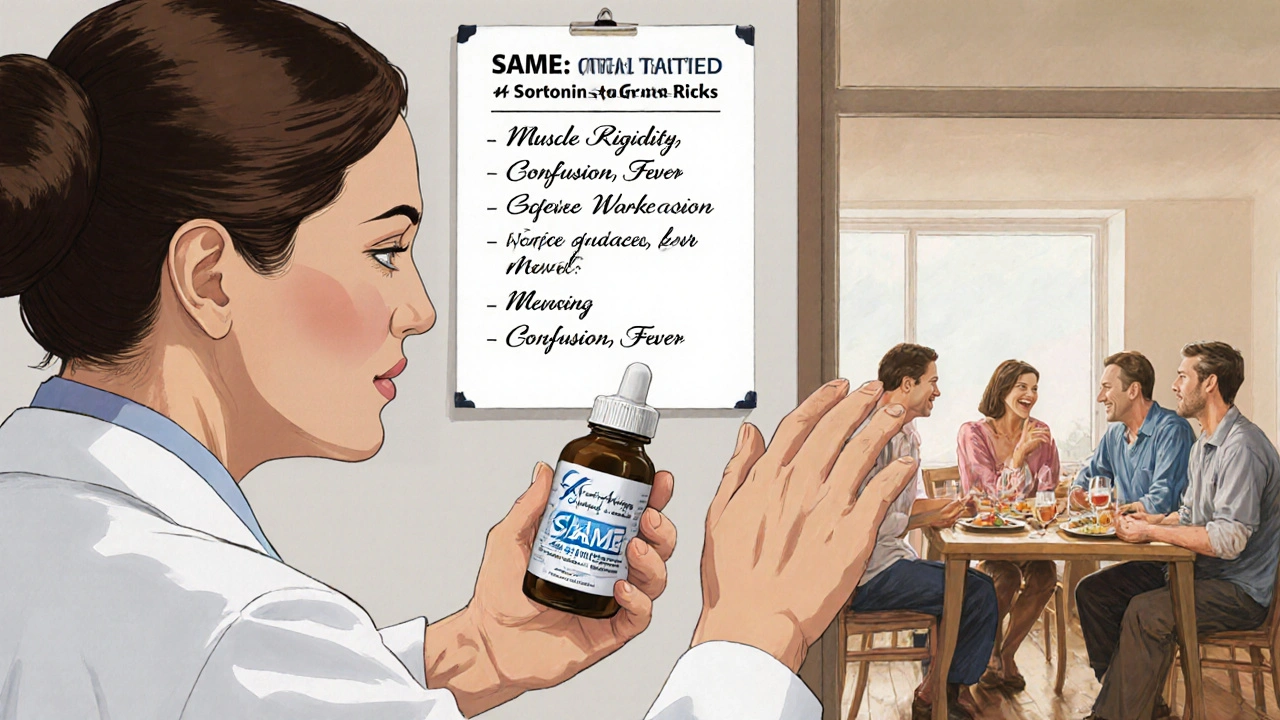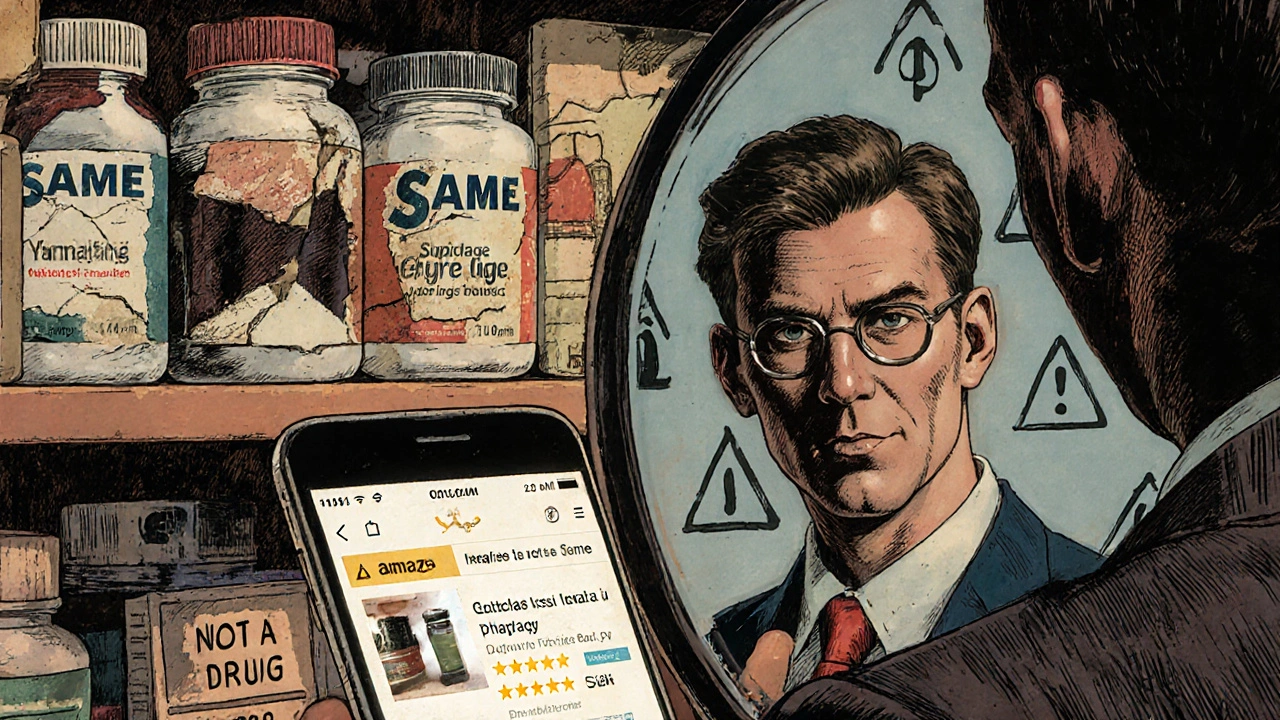SAMe and Antidepressants: What You Need to Know About Mood Effects and Interaction Risks
 Oct, 30 2025
Oct, 30 2025
Combining SAMe with antidepressants might seem like a smart way to boost mood faster-but it’s not without serious risks. People turn to SAMe because it’s natural, available over the counter, and promises quicker relief than traditional antidepressants. But what most don’t realize is that mixing it with SSRIs or SNRIs can trigger serotonin syndrome-a potentially life-threatening condition. This isn’t theoretical. Emergency rooms see cases every year, and the data shows it’s more common than most assume.
What Is SAMe, Really?
S-adenosylmethionine, or SAMe, is a compound your body makes naturally. It’s involved in over 200 chemical reactions, especially those that affect brain chemicals like serotonin, dopamine, and norepinephrine. Think of it as a methyl donor-it helps build and activate neurotransmitters. That’s why it’s been studied for depression since the 1970s.
Unlike prescription antidepressants, SAMe isn’t regulated as a drug. The FDA treats it as a dietary supplement, meaning manufacturers don’t need to prove it works before selling it. Most products come in 400mg or 800mg enteric-coated tablets, designed to survive stomach acid so more of it reaches your bloodstream. But here’s the catch: not all supplements are created equal. ConsumerLab’s 2022 testing found that 32% of SAMe products contained less active ingredient than labeled-some by as much as 25%.
People who use SAMe often report feeling better within 7 to 10 days, compared to the 2 to 4 weeks it takes for SSRIs to kick in. In mild-to-moderate depression, studies show about 35-50% of users respond positively. That’s lower than the 60-70% response rate for drugs like sertraline or escitalopram, but still meaningful for those who haven’t found relief elsewhere.
How SAMe Affects Mood-And Why It’s Risky With Antidepressants
SAMe doesn’t just boost serotonin production. It also appears to slightly inhibit monoamine oxidase, the enzyme that breaks down serotonin. That’s the same mechanism some older antidepressants (MAOIs) use. When you add SAMe to an SSRI or SNRI-drugs that already prevent serotonin reuptake-you’re essentially double-dosing on serotonin activity.
This combination can push your system into serotonin syndrome. Symptoms include:
- Racing heart or high blood pressure
- Muscle stiffness or twitching
- Confusion, agitation, or hallucinations
- Excessive sweating or fever
- Shivering or tremors
The Hunter Criteria-a clinical tool used in hospitals-defines serotonin syndrome by specific combinations of these signs. A single symptom like a tremor isn’t enough. But tremor plus hyperreflexia plus fever? That’s a red flag.
Between 2000 and 2022, only about 12 published case reports linked SAMe-antidepressant use to serotonin syndrome. But that’s likely an undercount. The FDA’s adverse event database recorded 32 SAMe-related incidents involving antidepressants between 2018 and 2022, including 9 serious cases. One Reddit user described racing heart, muscle rigidity, and confusion after adding 400mg SAMe to 20mg Prozac-ending up in the ER.
Who Should Avoid SAMe With Antidepressants?
Not everyone who takes SAMe and antidepressants has problems. Some people, like one Healthline forum user, report smooth results after 8 months of combining 800mg SAMe with Zoloft. Their PHQ-9 score dropped from 16 to 7. But those are exceptions.
Doctors at Massachusetts General Hospital and McLean Hospital agree: SAMe should only be considered as an add-on for treatment-resistant depression-not as a first choice. And even then, it needs careful management.
People who should avoid this combo entirely include:
- Those with severe depression or melancholic features (remission rates drop to 18% with SAMe vs. 42% with venlafaxine)
- Anyone already taking MAOIs or other serotonergic drugs (like tramadol, dextromethorphan, or certain migraine meds)
- Individuals with a history of bipolar disorder-SAMe can trigger mania
- People with liver disease, since SAMe metabolism depends on liver function
Also, SAMe isn’t stable. It needs refrigeration. If your bottle’s been sitting on the counter for months, it might be degraded-and ineffective. A 2016 study showed enteric-coated tablets boost bioavailability from 5% to 95% when stored properly.

What Does the Science Say About Combining SAMe and Antidepressants?
There’s no clear consensus. The American Psychiatric Association’s 2023 guidelines say SAMe lacks sufficient evidence for routine use. The European Food Safety Authority banned it in 2015 over safety concerns. Meanwhile, the U.S. lets it fly off shelves with minimal warnings.
A 2017 meta-analysis compared SAMe to escitalopram in treating depression. SAMe reduced depression scores by 12.3 points on the Hamilton scale. Escitalopram? 15.7. Not a huge gap, but enough to show it’s not superior. Where SAMe shines is in people with depression and osteoarthritis. One study found it cut pain 30% more than duloxetine alone.
But the biggest issue isn’t effectiveness-it’s predictability. SAMe absorption varies wildly between people. Some absorb 15% of the dose. Others get 50%. That makes dosing guesswork. And because it crosses the blood-brain barrier in under an hour, effects hit fast. That’s good if you’re responsive. Bad if you’re not-and you start feeling anxious, jittery, or worse.
Studies show 22% of users experience initial anxiety spikes before improvement. That’s why experts recommend starting low: 200mg twice daily, increasing by 200mg every 5-7 days under supervision. Never jump to 1600mg overnight.
Real-World Risks and What Manufacturers Don’t Tell You
Here’s the uncomfortable truth: most SAMe bottles don’t warn you about antidepressant interactions. A 2021 JAMA Internal Medicine review found only 37% of products included any mention of serotonin syndrome risk. Amazon reviews show 28% of negative feedback cites stomach upset-but almost none mention the neurological dangers.
Price is another barrier. A month’s supply of SAMe costs $80-$120. For comparison, generic sertraline runs under $10. And you’re paying for something that’s not guaranteed to work-and could land you in the hospital.
Even the FDA is stepping in. In early 2023, it sent warning letters to three SAMe manufacturers for claiming their products treat depression. That’s illegal. Supplements can’t make disease treatment claims. Yet, many websites still say things like “SAMe works like Prozac.” That’s misleading-and dangerous.

What Should You Do If You’re Considering SAMe?
If you’re thinking about trying SAMe:
- Talk to your doctor first. Don’t self-prescribe. Tell them exactly what you’re taking-even if you think it’s “just a supplement.”
- Don’t combine it with antidepressants unless under close supervision. If your doctor agrees, start at 200mg twice daily. Monitor for symptoms for at least 4 weeks.
- Buy from trusted brands. Look for third-party tested products (USP, NSF, or ConsumerLab verified). Avoid cheap Amazon brands with no testing data.
- Store it right. Keep it refrigerated. If it’s been sitting out for months, toss it.
- Know the warning signs. If you get sudden muscle stiffness, confusion, or a racing heart after starting SAMe, stop immediately and seek help.
Some people benefit from SAMe-especially those who can’t tolerate antidepressants or have depression tied to chronic pain. But it’s not a magic fix. And it’s not safe to use casually.
What’s Next for SAMe Research?
A major NIH-funded trial (NCT04821234) is currently studying SAMe combined with escitalopram. Results are expected in mid-2024. If they show clear safety and efficacy, it could lead to standardized dosing protocols.
Researchers are also developing modified versions of SAMe-like SAMe-PEG and SAMe-phospholipid complexes-that appear to reduce serotonin interaction risk by 40% in animal models. These are still in early trials, but they point to a future where SAMe might be safer.
For now, the message is simple: SAMe isn’t harmless. It’s a powerful compound with real drug-like effects. Using it with antidepressants is like playing Russian roulette with your brain chemistry. The odds aren’t in your favor unless you’re under expert care.
Can I take SAMe instead of my antidepressant?
No. SAMe is not a proven replacement for prescription antidepressants, especially in moderate to severe depression. Studies show it has lower overall effectiveness than SSRIs and SNRIs. Stopping your antidepressant without medical guidance can lead to withdrawal symptoms or worsening depression. If you want to switch, work with your doctor to taper safely and monitor your symptoms.
How long does SAMe take to work for depression?
Some people notice mood improvements within 7 to 10 days, which is faster than most antidepressants. But this varies. Others take 4 to 6 weeks to see changes. Initial side effects like anxiety or nausea can appear before benefits, so give it at least 3 weeks before deciding if it’s working. Never increase the dose too quickly.
Does SAMe cause weight gain?
Unlike many antidepressants, SAMe isn’t linked to weight gain. In fact, some users report reduced appetite or mild nausea, especially at higher doses. If you’re gaining weight while taking SAMe, it’s likely due to other factors-like improved mood leading to better eating habits, or another medication you’re on.
Is SAMe safe for long-term use?
There’s no solid data on long-term safety beyond 12 months. Most clinical trials last 6-12 weeks. While no major organ damage has been reported, the risk of serotonin syndrome remains even with long-term use, especially if combined with other serotonergic drugs. Regular check-ins with your doctor are essential if you plan to use SAMe for months or years.
Can I take SAMe with alcohol?
Avoid alcohol while taking SAMe. Alcohol can worsen liver stress and may interfere with SAMe’s metabolism. It can also worsen depression symptoms and increase the risk of side effects like dizziness, nausea, or mood swings. Even moderate drinking isn’t recommended when using SAMe, especially if you’re also on antidepressants.

Marcia Facundo
November 1, 2025 AT 01:12I tried SAMe last year after my doctor said I could try it with my SSRI. Felt like my brain was buzzing under my skull for three days. Didn't tell anyone until I ended up in urgent care. Now I just stick to therapy and walking my dog. Simple works.
Ajay Kumar
November 2, 2025 AT 02:51You people are so scared of natural supplements. In India we've used Ayurvedic compounds like Ashwagandha and Brahmi for centuries without ER visits. SAMe is just another molecule your pharmaceutical overlords don't control. The real danger is prescription drugs with 47 side effects listed in tiny print. Your body makes SAMe naturally-why are you afraid of what your own liver produces? The FDA is a corporate puppet. They banned turmeric extract last year too. This is control, not care.
Joseph Kiser
November 4, 2025 AT 01:54Let me be real with you. This isn't about supplements. It's about how broken our mental health system is. People turn to SAMe because they can't afford therapy, can't wait 6 weeks for SSRIs to work, and their doctor won't listen. I've seen patients on 800mg SAMe + sertraline for 18 months with zero issues-because they were monitored. The problem isn't SAMe. It's the lack of access to care. You want to prevent serotonin syndrome? Train primary care docs to screen for it. Don't scare people off natural options with fearmongering. And for god's sake, stop pretending supplements are 'dangerous' when your insurance won't cover a single therapy session. 😔
Hazel Wolstenholme
November 5, 2025 AT 23:32One must interrogate the epistemological foundations of supplement regulation in the United States. The FDA's classification of SAMe as a dietary supplement-rather than a pharmacologically active agent-is a profound ontological error, rooted in the neoliberal commodification of health. The very notion that a compound which modulates monoamine oxidase and acts as a methyl donor can be legally marketed without rigorous pharmacokinetic scrutiny is not merely negligent-it is an epistemic failure of the highest order. One wonders whether the same logic would permit the sale of lithium chloride as a 'mood-enhancing tea' if it were derived from mineral springs. The cultural myopia surrounding 'natural' remedies is a form of epistemic violence, particularly when juxtaposed against the rigorous double-blind protocols governing pharmaceuticals. One cannot have it both ways: either SAMe is a drug, or it is inert. It is not a 'gentle alternative.' It is a potent biochemical modulator. The market, not medicine, is its gatekeeper-and that is the tragedy.
Mike Laska
November 7, 2025 AT 00:14MY BEST FRIEND GOT SEROTONIN SYNDROME FROM SAMe + ZOLOFT. SHE WAS IN THE ICU FOR 5 DAYS. SHE COULDN'T WALK. HER MUSCLES WERE LOCKED. SHE THOUGHT SHE WAS DYING. I SAW HER. I HELD HER HAND. I WILL NEVER LET ANYONE TELL ME THIS IS 'JUST A SUPPLEMENT.' IT'S A TIME BOMB IN A BOTTLE. AND THE FACT THAT AMAZON SELLS IT FOR $20 WITH NO WARNINGS IS A CRIME. STOP GLOSSING IT OVER. THIS ISN'T A BLOG POST. THIS IS LIFE OR DEATH.
Eileen Choudhury
November 7, 2025 AT 20:26I get it-people want quick relief. I was there too. But SAMe isn't magic. It's a tool. And tools need instructions. I started with 200mg, kept it refrigerated, and told my psychiatrist. Took 3 weeks to feel anything. No ER trips. No panic. Just slow, steady progress. If you're gonna do this, do it right. Don't be reckless. Your brain is worth more than a $75 bottle from Amazon. 💪
Zachary Sargent
November 8, 2025 AT 14:00My uncle took SAMe with his Lexapro and ended up in the hospital screaming about the walls talking. He didn't even know it could do that. Now he's on disability. The supplement industry is a scam. They don't care if you live or die. They just want your money. Don't be the next statistic.
Melissa Kummer
November 9, 2025 AT 17:25While the pharmacological profile of S-adenosylmethionine presents compelling biochemical pathways for neuromodulation, the regulatory vacuum surrounding its commercial distribution constitutes a significant public health vulnerability. The absence of standardized dosing, bioavailability controls, and mandatory adverse event reporting renders consumer use inherently unpredictable. Furthermore, the cultural romanticization of 'natural' interventions often obscures the pharmacodynamic potency of such compounds. It is not the substance that is dangerous-it is the unregulated ecosystem in which it is deployed. Rigorous clinical oversight, not fear, is the ethical imperative.
andrea navio quiros
November 10, 2025 AT 20:26Pradeep Kumar
November 12, 2025 AT 17:25From India, I’ve seen families use turmeric, ashwagandha, and even Brahmi for mood. But we also respect our elders and doctors. SAMe? Maybe it helps. But don’t mix it blindly. I had a cousin who took it with fluoxetine-woke up shaking, heart racing. Took him to hospital. He’s fine now. But he learned. Listen to your body. Talk to someone who knows. Don’t trust Amazon reviews. 🙏
Andy Ruff
November 13, 2025 AT 19:24Let’s be honest. You people are just looking for an excuse to avoid real treatment. You want to pop a $100 supplement instead of doing the hard work of therapy, lifestyle changes, or even just getting off your couch. SAMe doesn’t fix trauma. It doesn’t fix bad sleep. It doesn’t fix your toxic relationships. It just gives your brain a chemical jolt and hopes for the best. And when it goes wrong, you blame the supplement. No. You blame yourself for being lazy and irresponsible. Stop pretending you’re being 'natural' when you’re just being reckless. Your brain isn’t a lab experiment. Treat it like it matters.
Pritesh Mehta
November 14, 2025 AT 13:35Western medicine is a colonial fraud. In ancient Ayurveda, we used Brahmi and Jatamansi for depression long before Prozac was invented. SAMe is just a modern mimic of these traditional compounds. But your FDA, your Big Pharma, your corporate science-they don't want you to know this. They profit from dependency. They fear natural alternatives because they can't patent them. Why do you think they suppress studies? Why do they label safe, ancient compounds as 'dangerous'? It's not about safety. It's about control. Your body is not a machine to be managed by pills. It's a sacred system. Trust your ancestors. Trust nature. Stop bowing to the white-coated priests of Wall Street.
Billy Tiger
November 15, 2025 AT 11:27